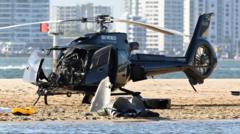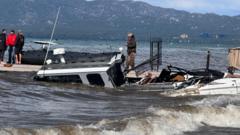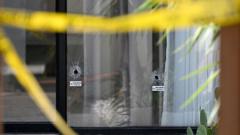The investigation highlights significant safety lessons for aviation operators following the mid-air accident that occurred at a popular theme park.
Fatal Helicopter Collision in Australia Linked to Faulty Antenna

Fatal Helicopter Collision in Australia Linked to Faulty Antenna
Antenna malfunction cited as key factor in tragic Gold Coast helicopter crash that resulted in four fatalities.
A recent investigation has uncovered that a malfunctioning radio antenna significantly contributed to a tragic mid-air helicopter collision over Australia’s Gold Coast, which resulted in the deaths of four individuals, including two British tourists. This accident, which took place in January 2023 near Sea World, involved two helicopters colliding shortly after one took off and the other landed. Six additional passengers were left with serious injuries.
Australia's Transport and Safety Bureau (ATSB) revealed that one of the pilots failed to hear a critical radio communication just before the incident occurred. In the months leading up to the crash, changes at Sea World, including the addition of a second helipad and larger helicopters, gradually weakened the effectiveness of risk management protocols. The crash sent shockwaves through the popular tourist destination.
According to the ATSB report, the two helicopters crashed approximately twenty seconds after one departed. The helicopter that was taking off carried all four individuals who lost their lives, while the other managed to execute an emergency landing, albeit with various injuries sustained by its passengers.
The report also disclosed that the helicopter intended for takeoff was equipped with a faulty antenna. In the moments leading to the accident, vital communication from the incoming helicopter either was not received or ignored by the pilot loading passengers on the departing chopper. Even after boarding was complete, a ground crew member mistakenly informed the pilot that the airspace was clear, a statement which had become outdated by the time of departure.
The pilot landing after a scenic flight had initially noticed the other helicopter on the ground but did not perceive it as a threat. The report indicated that he would have expected to receive a taxiing radio call if conditions had changed. However, due to the antenna malfunction, such a critical communication fail occurred, resulting in a lack of situational awareness for the landing pilot, thereby increasing the risk of a collision.
Among the deceased were Diane Hughes, 57, and her husband Ron, 65, from Neston, Cheshire, who were celebrating their honeymoon after a COVID-related separation. Also among the victims was 36-year-old Vanessa Tadros from Sydney and 40-year-old helicopter pilot Ashley Jenkinson, originally hailing from Birmingham. The crash injured six individuals severely while three others sustained minor wounds.
The pilot of the returning helicopter was hailed as a "hero" by passengers after safely landing amid the chaos. The ATSB reported a total of 28 findings from the investigation to emphasize crucial lessons for aviation professionals. ATSB Chief Commissioner Angus Mitchell reinforced that even well-intentioned changes in aviation operations can have unforeseen consequences, making it vital to follow a structured process to maintain safety.




















